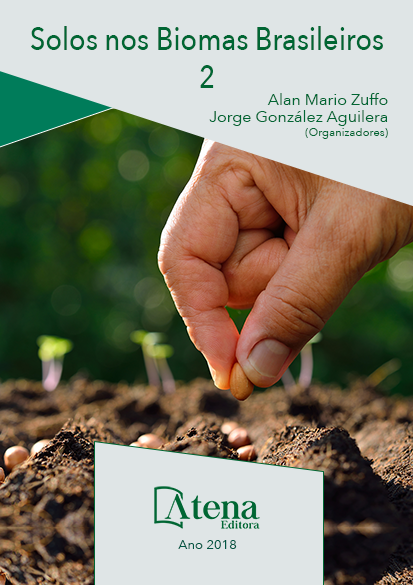
DISTRIBUIÇÃO ESPACIAL DAS RAÍZES DO MILHO SUBMETIDO A ADUBAÇÃO MINERAL EM SISTEMA DE PLANTIO DIRETO
O sistema radicular tem como
funções principais sustentar a planta e absorver
água e nutrientes para o seu desenvolvimento e
produção. Objetivou-se com o presente trabalho
determinar a produção de biomassa radicular
do milho, submetido a diferentes doses de N (5;
30; 50; 70 e 95 kg ha-1) e K (4; 24; 40; 56 e 76 kg
ha-1). O experimento foi conduzido na estação
experimental Chã-de-Jardim pertencente
ao CCA/UFPB. O experimento foi montado
seguindo um delineamento experimental em
blocos casualizados, com 11 tratamentos
e cinco repetições. Os tratamentos foram
dispostos conforme a matriz Plan Puebla III. O
potássio e o fósforo foram aplicados todos em
fundação, juntamente com 30% do nitrogênio. O
restante do nitrogênio foi aplicado em cobertura
aos 40 dias após o plantio, sem incorporação.
A coleta da raiz do milho foi realizada 75 dias
após o plantio, sendo coletada três amostras
por parcela, na profundidade de 0-10, 10-20 e
20-40 cm. A 10 cm de profundidade a biomassa
radicular do milho foi de 4730 kg ha-1 na
combinação das doses de 95 kg ha-1 de N e 4 kg
ha-1 de K. Na profundidade de 10-20 o acumulo
de biomassa foi de 2395 kg ha-1 também nas
doses combinada de 95 kg ha-1 de N e 4 kg
ha-1 de K. Para profundidade de 20-40 cm,
constatou-se uma produção média de biomassa
radicular de 437,31 kg ha-1. O incremento das
doses de N, favoreceu o aumento no acumulo
de biomassa radicular
DISTRIBUIÇÃO ESPACIAL DAS RAÍZES DO MILHO SUBMETIDO A ADUBAÇÃO MINERAL EM SISTEMA DE PLANTIO DIRETO
-
DOI: 10.22533/at.ed.0941814123
-
Palavras-chave: Sistema Radicular, Nitrogênio, Potássio.
-
Keywords: Root System, Nitrogen, Potassium.
-
Abstract:
The application of balanced doses
of nutrients in the corn crop provides adequate
growth and development for the plant, favoring
a higher production of biomass of the root system, consequently, exploring a larger volume of soil, therefore, having at its disposal
a greater amount of water and nutrients, culminating in increased productivity. The
objective of this work was to determine the root biomass production of maize, submitted
to different doses of N (5, 30, 50 and 95 kg ha-1) and K (4, 24, 40, 56 and 76 kg ha-1).
The experiment was conducted at the Chã-do-Jardim experimental station belonging
to the CCA / UFPB. The experiment was set up in a randomized complete block design
with 11 treatments and five replicates. The treatments were arranged according to Plan
Puebla III matrix.The potassium and phosphorus were all applied on a foundation,
together with 30% of the nitrogen. The rest of the nitrogen was applied in the 40 days
after planting, next to the line, without incorporation. The corn rootworm was collected
75 days after planting, and three samples per plot were collected at depths of 0-10,
10-20 and 20-40 cm. At 10 cm depth the corn root biomass was 4730 kg ha-1 in the
combination of the doses of 95 kg ha-1 of N and 4 kg ha-1 of K. At depth of 10-20 the
accumulation of biomass was of 2395 kg ha-1 also at the combined doses of 95 kg
ha-1 of N and 4 kg ha-1 of K. For depth of 20-40 cm, a mean root biomass production
of 437.31 kg ha-1. The increase of N doses favored an increase in the accumulation of
root biomass
-
Número de páginas: 15
- Helton de Souza Silva


